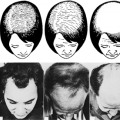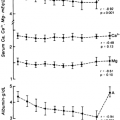EMPTY SELLA SYNDROME
Extension of the subarachnoid space into the sella turcica through a deficient sellar diaphragm may manifest itself clinically and radiologically as a syndrome mimicking pituitary adenoma. The empty sella may be defined as nontumorous remodeling that results from a combination of incomplete diaphragma sellae and CSF fluid pressure.96
Diaphragmal openings are common; in one study, defects >5 mm were found in 39% of normal autopsy cases.97 The sella is characteristically enlarged, but an empty sella may be of normal size. Primary empty sella occurs spontaneously and may be associated with arachnoidal cysts or, possibly, infarction of the diaphragma and pituitary. Secondary empty sella follows pituitary surgery or radiotherapy (see Chap. 11 and Chap. 17) and may also be seen in cases of elevated intracranial pressure (e.g., pseudotumor cerebri or hydrocephalus). Neuroradiographic evidence of a reversible empty sella syndrome after therapy for idiopathic intracranial hypertension has been reported.98 Visual field defects, hypopituitarism, headaches, and spinal fluid rhinorrhea occasionally occur. A thorough review of the clinical and radiographic characteristics of primary empty sella99 has revealed the following features: obese women predominate,
ranging in age from 27 to 72 years, with a mean age of 49 years; headache is a common symptom; there is no vision impairment because of chiasmal interference; usually, an enlarged sella turcica is found serendipitously on radiologic studies obtained for evaluation of headaches, syncope, or other symptoms; pseudo-tumor cerebri was present in 13% of patients; approximately two-thirds of the patients had normal pituitary function; and the remaining one-third demonstrated endocrine disturbances, including panhypopituitarism and growth hormone, gonadotropin, and thyrotropin deficiency. In another series of patients with primary empty sella,100 the following features are noteworthy: all 19 were female; 12 patients initially reported headache; in 7, vision disturbances were prominent subjective symptoms (blurred vision, diplopia, micropsia); 3 patients had bilateral papilledema, and pseudotumor cerebri was diagnosed; and 2 patients demonstrated minimal, relative hemianopias without obvious cause. Additionally, visual field defects typical of those seen in glaucoma are well documented in patients with empty sella syndrome; the normal intraocular pressures implicate the empty sella syndrome as a potential cause of so-called low-tension glaucoma.101
ranging in age from 27 to 72 years, with a mean age of 49 years; headache is a common symptom; there is no vision impairment because of chiasmal interference; usually, an enlarged sella turcica is found serendipitously on radiologic studies obtained for evaluation of headaches, syncope, or other symptoms; pseudo-tumor cerebri was present in 13% of patients; approximately two-thirds of the patients had normal pituitary function; and the remaining one-third demonstrated endocrine disturbances, including panhypopituitarism and growth hormone, gonadotropin, and thyrotropin deficiency. In another series of patients with primary empty sella,100 the following features are noteworthy: all 19 were female; 12 patients initially reported headache; in 7, vision disturbances were prominent subjective symptoms (blurred vision, diplopia, micropsia); 3 patients had bilateral papilledema, and pseudotumor cerebri was diagnosed; and 2 patients demonstrated minimal, relative hemianopias without obvious cause. Additionally, visual field defects typical of those seen in glaucoma are well documented in patients with empty sella syndrome; the normal intraocular pressures implicate the empty sella syndrome as a potential cause of so-called low-tension glaucoma.101
Stay updated, free articles. Join our Telegram channel

Full access? Get Clinical Tree





